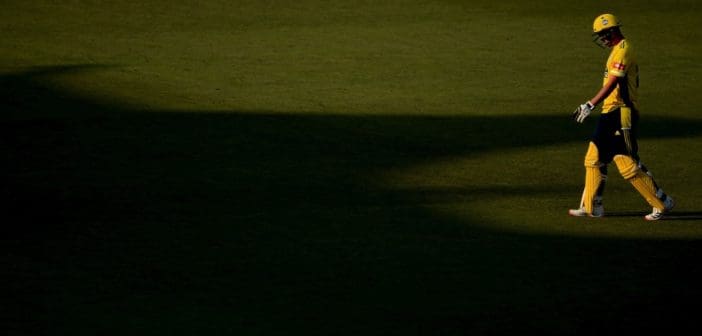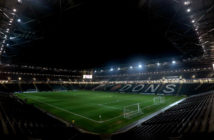Imagine a sports car with an empty gas tank. Or a brand-new state-of-the-art amphitheatre that solely holds children productions.
Both of which would be hard to fathom. If either situation ever arose, it would be the most apt denotation of Seyed Moussavi’s ‘style without substance’ remark.
Moussavi’s line is often used in team sports, underpinned as a common critique to describe a group that isn’t functioning at optimal levels. The team may be talented and may boast a wealth of resources, but they lack the required mettle to be successful.
So, instead, they are looked upon as brittle and frail, where the tangible evidence doesn’t quite level up with the intangible hype that encompasses them. Consequently, it leaves a skilled, yet inconsistent group of players that plateau’s in results. Despite the extensive assets or the abundance of gifted personnel, they are left behind the curve.
Hampshire’s Ageas Bowl is one of the most advanced cricketing grounds in the country. Intertwined with its picturesque backdrop, the stadium is a modern, refreshing change from the typically archaic cricket grounds in the UK. Formerly baptised the Rose Bowl, it opened in 2001 and has since been renovated over the past five years, with a luxury 171-room hotel built opposing the pavilion.
Described as featuring “stunning architecture and design,” the Hilton Hotel opened in 2015 and promised to take Hampshire County Cricket Club to the next level. Chairman Rod Bransgrove declared it to be “undoubtedly one of the best cricket grounds in the world,” before adding the club was “looking forward to the next phase of the exciting journey.”
If it wasn’t the aim 14 years prior, the inclusion of a high-end hotel was set to transcend Hampshire’s fortunes. It signalled a change in direction, a change in ambition. No longer were they going to settle within the chasing pack, hunting the country’s larger counties, nor were they content to simply smoulder and be one of the many mere mortals.
The project was 10 years in the making and brought an end to the decade of hardwork they and the Eastleigh Borough Council endured. Bransgrove admittance of “blood, sweat and the odd tear” was all in sacrifice that the hotel would bring new, untold riches and untapped success for all parties involved.
The progressive facilities at the Ageas made it no surprise that the ECB chose it to be one of two ‘bio-secure environments’ for the England cricket team over the summer. Along with the central campus, it held large practice sites, a golf course, a wellbeing centre and 200 car parking spaces. More pertinently, it also held the capacity for a 1500-metre area for medical screening and testing.
England staged three of their six Test matches at the Ageas, more that’s ever been seen at the ground. In the preceding 18 years, Hampshire had hosted just two Tests. While there were no fans, the international summer was a commercial success for Hampshire, praised for its competitive pitches and attentive support network. After all those years fighting to be recognised, they had finally achieved it.
But when the ECB packed up their suitcases and headed home, the Hampshire squad returned to begin their T20 Vitality Blast campaign. After being unable to play games at the ground earlier on in the summer – due to England’s residence – the Royals hoped home comforts would spark life into what was becoming a rather mundane season.
Their Bob Willis Trophy campaign never really got going, finishing fourth out of six in the south group. No Hampshire batsman made it into the top 30 run-scorers, with Joe Weatherley averaging the highest at a tick under 44.
But Hampshire were now back home. They were swapping the red ball for the white ball, something that always came easier to them. At one point, they were the leading limited-overs set-up in the country, winning the T20 tournament twice in the space of three years, with a win at Lords in the CB40 final thrown in for good measure. The homecoming was assumed to be the desperately needed spark that would ignite their season.
It turned out to be anything but.
Hampshire finished bottom. 10 games, two wins, seven defeats and one no result. Initial optimism had dissipated into defeatism. Not even Ravi Shastri’s glowing review of Hampshire having the “best cricket facility on the UK circuit” would offer much consolation. The quaint, charming settings were paradoxical to the drab the team were serving up on the pitch.
Yes, T20 is all about the outrageous and the downright sublime, but Hampshire’s batting this season bordered on idiocy. They either didn’t seem to get it off the square or when they did, they would hole out in the deep. It was all or nothing cricket. And most of the time, it would end up as nothing. They seemed lost in run chases and would misread what the pitch would do, time and time again.
Batsman would run past balls, some, like James Fuller, would even epitomise Hampshire’s absurd displays by managing to step onto his own wickets.
To underline how far they are behind the curve, you just need to take a look at the Vitality Blast’s batting averages. Fuller recorded Hampshire’s highest, yet ranked 40th in the country. And that mainly came with the caveat of four not outs, meaning his average substantially boosted to 34. There was no other Royals’ batsman in the top 50.
Bowling wasn’t much better; Felix Organ – Hampshire’s County Championship batting opener – was 23rd, taking wickets at 18 a piece. But, again, it came with a notable proviso, as those figures were taken from a scant sample size. Organ had bowled just eight overs and played three matches, all at the end of the campaign when Hampshire were just simply trying to get 11 bodies on the pitch.
“Our batting needs improvement,” said Liam Dawson during their penultimate game against Surrey. “Our bowling has been okay, but it’s getting runs on the board that’s been the issue.” Hampshire’s powerplay metrics show batting has proven to be a long term issue, rather than a fleeting one that’s just came to fruition. In the previous 23 games, they have lost 19 wickets in the first two overs.
All successful T20 outfits have the ability to adapt, the propensity – tactically and technically – to learn from their mistakes. This, in turn, means they evolve into something better for the next game; Hampshire do not. Fielding has become another facet that’s spiralled out of control, with misfields scattered in every game. “Our body language has gone,” Dawson confessed.
“We haven’t been beaten closely, we’ve been hammered. It’s not good enough and we have to look at ourselves and the team.”
Dawson, who spent the season out with a ruptured achilles, was commentating for Radio Solent and unable to hide his evident frustration. The all-rounder made no bones as to how bad the situation is at the Ageas, something which seemed unimaginable when Rod Bransgrove cut the blue-ribband tape and opened the Hilton Hotel for the cricketing world to dazzle at.
After the Surrey defeat Dawson was asked as to where Hampshire go from here. In a somewhat perverse way, Dawson suggested to “not turn up for Sunday,” – which happened to be Hampshire’s last fixture of the season. “It’s got to the point where we are wishing the season to end.”
Hampshire did win on that particular Sunday, but talk about too little, too late.
Dawson continued. “You don’t mind losing games of cricket, but we’ve not even been in a contest for the majority of the season. It’s not good enough, it’s poor. I think supporters are going to be angry and that’s fair enough. It has been a shocking campaign for Hampshire.”
“Teams play better than us here. We haven’t adapted at all. We play to win trophies and the last couple of years, we haven’t been close.” Dawson’s words were damning but rung true.
When Rod Bransgrove flashed his pride and revered the modernisation to one of the most-advanced cricket grounds in 2015, he had done so in expectation. He expected Hampshire’s “exciting journey” to be much further along than it is right now.
Follow us on Twitter @ProstInt
![Prost International [PINT]](https://prostinternational.com/wp-content/uploads/2021/08/PINTtFontLogoRoboto1536x78.jpg)



